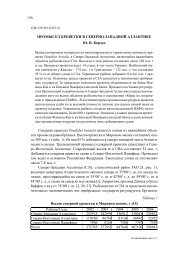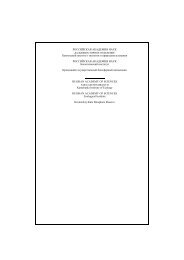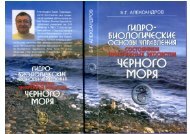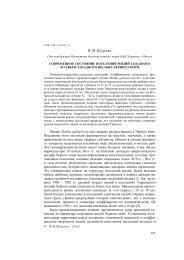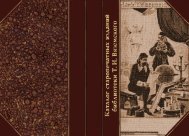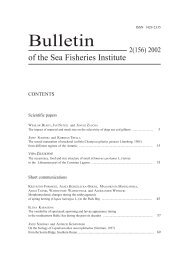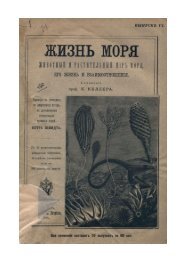Bulletin of the Sea Fisheries Institute 2 (153) 2001 - CEEMaR
Bulletin of the Sea Fisheries Institute 2 (153) 2001 - CEEMaR
Bulletin of the Sea Fisheries Institute 2 (153) 2001 - CEEMaR
You also want an ePaper? Increase the reach of your titles
YUMPU automatically turns print PDFs into web optimized ePapers that Google loves.
16<br />
JONATHAN A. HARE et al.<br />
Species Identification<br />
Larval fish from MOCNESS, bongo and BN-1 collections were removed, identified,<br />
enumerated and measured by staff <strong>of</strong> <strong>the</strong> Polish Plankton Sorting and Identification Center.<br />
Larval fish from neuston collections were removed, identified, enumerated and measured by<br />
employees <strong>of</strong> <strong>the</strong> NOAA Beaufort Laboratory. All scombrid and scombrolabracid identifications<br />
were verified by two <strong>of</strong> <strong>the</strong> authors (JAH and ABP) using published sources, primarily Potth<strong>of</strong>f<br />
(1974), Richards (1989) and Richards et al. (1990).<br />
Most Thunnus larvae were identified as T. atlanticus. All larvae identified to Thunnus<br />
atlanticus had one to several very small melanophores on <strong>the</strong> ventral margin. The most common<br />
location was ventral to <strong>the</strong> hypural, but most specimens also had one to three very small<br />
melanophores on <strong>the</strong> posterior half <strong>of</strong> <strong>the</strong> ventral margin. In many <strong>of</strong> <strong>the</strong> specimens <strong>the</strong>se<br />
melanophores were not evident at first, but careful examination revealed pigment. A subset <strong>of</strong><br />
specimens with this pigment pattern were cleared and stained (n = 41) and all had vertebral<br />
counts <strong>of</strong> 19 + 20, identifying <strong>the</strong>se larvae as T. atlanticus. This pigment pattern was <strong>the</strong>n used<br />
to identify o<strong>the</strong>r larvae as T. atlanticus. Thunnus larvae with no ventral pigment were not<br />
identified below genus.<br />
Data Analysis<br />
<strong>Sea</strong>sonal abundances <strong>of</strong> scombrid and scombrolabracid larvae were compared between cruises.<br />
Only data from <strong>the</strong> two stations that were sampled during both cruises were analyzed<br />
(igure 1). Total number <strong>of</strong> larvae <strong>of</strong> each taxa collected at a station were divided by total water<br />
filtered at each station and concentrations expressed in 100 m -3 .<br />
Vertical distributions <strong>of</strong> scombrid and scombrolabracid larvae were examined from<br />
<strong>the</strong> May, 1984 MOCNESS collections. Concentration <strong>of</strong> larvae within a given depth strata<br />
at a given sampling time were expressed in 100 m -3 . Weighted mean depth (and standard deviation)<br />
<strong>of</strong> larvae were also calculated using larval concentrations (Brodeur and Rugen 1994).<br />
BN-1 collections were not analyzed in this manner owing to <strong>the</strong> limited number <strong>of</strong> larvae<br />
collected.<br />
Horizontal distributions <strong>of</strong> larvae were examined from <strong>the</strong> broad-scale, November-December<br />
1988 bongo collections. Neuston collections were not analyzed because <strong>of</strong> a strong<br />
day/night bias (see below). Stations were divided into three regions (igure 1) and non-parametric<br />
statistics were used to determine if larval concentrations and larval lengths differed<br />
among regions.<br />
RESULTS<br />
<strong>Sea</strong>sonal Abundance<br />
Larval abundance and length distributions indicated that scombrids and scombrolabracids<br />
spawned in both spring and winter in <strong>the</strong> Puerto Rico/St. Croix region (Table 1, igure 2).<br />
Katsuwonus pelamis and Scombrolabrax heterolepis larvae were collected in both May and<br />
November/December, and during both sampling times, most larvae were



